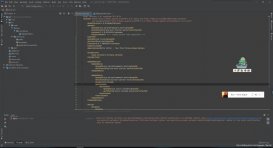1、场景
程序中经常需要对接口进行限流,防止访问量太大,导致程序崩溃。
常用的算法有:计数算法、
漏桶算法、令牌桶算法,最常用的算法是后面两种。
2、算法详解
2.1 计数算法
2.1.1 说明
技术算法,为最简单的限流算法。
核心思想是,每隔一段时间,为计数器设定最大值,请求一次,计数器数量减一,如果计数器为0,则拒绝请求。
计数器算法图示:
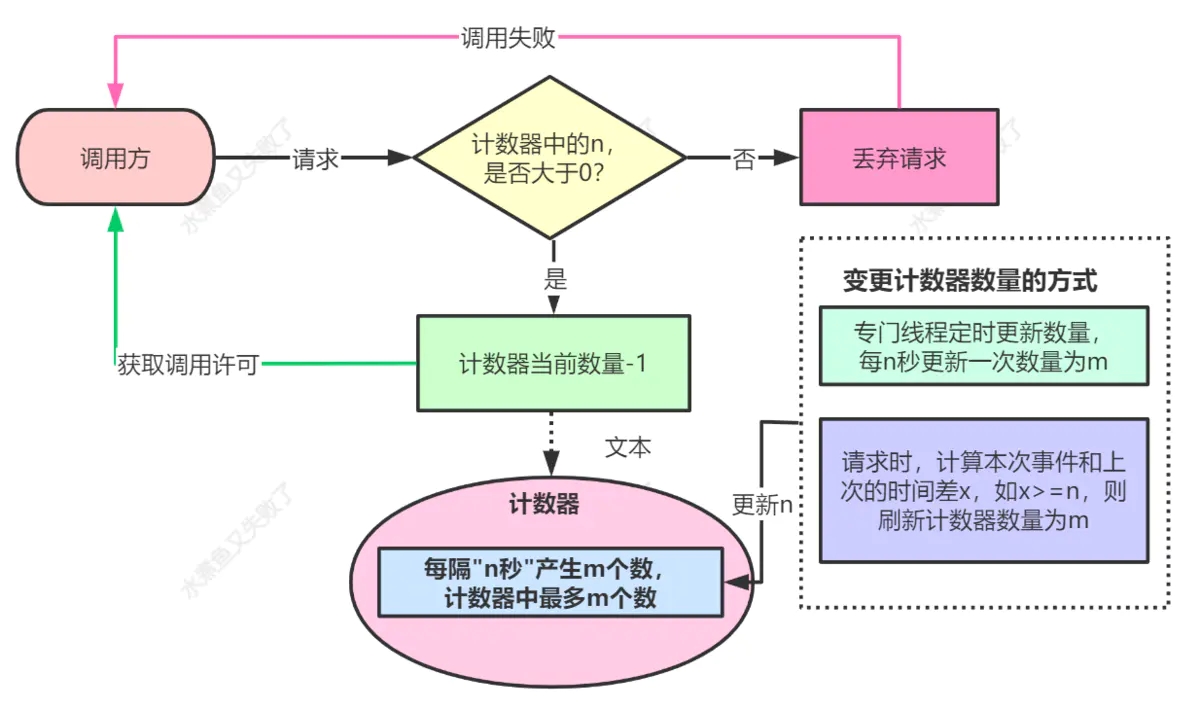
2.1.2 适用场景
虽然此算法是大多数人第一个想到可以限流的算法,但是不推荐使用此算法。
因为,此算法有个致命性的问题,如果1秒允许的访问次数为100,前0.99秒内没有任何请求,在最后0.01秒内,出现了200个请求,则这200个请求,都会获取调用许可,给程序带来一次请求的高峰。
如下图所示:计数器算法缺点
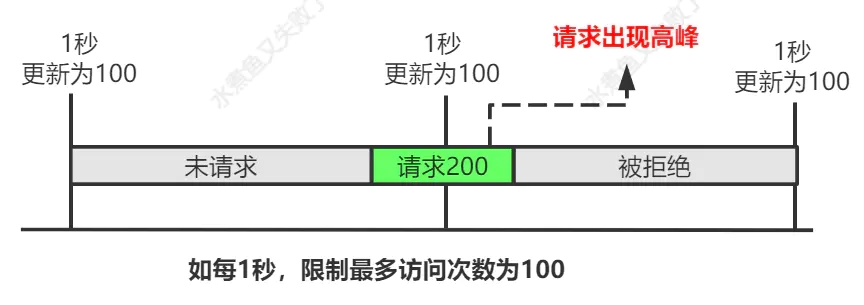
2.1.3 代码
|
1
2
3
4
5
6
7
8
9
10
11
12
13
14
15
16
17
18
19
20
21
22
23
24
25
26
27
28
29
30
31
32
33
34
35
36
37
38
39
40
41
42
43
44
45
46
47
48
49
50
51
52
53
54
55
56
57
58
59
60
61
62
63
|
import java.time.localdatetime;import java.util.concurrent.timeunit;/** * 计数器限流器 */public class countlimiter { /** * 执行区间(毫秒) */ private int secondmill; /** * 区间内计数多少次 */ private int maxcount; /** * 当前计数 */ private int currentcount; /** * 上次更新时间(毫秒) */ private long lastupdatetime; public countlimiter(int second, int count) { if (second <= 0 || count <= 0) { throw new illegalargumentexception("second and time must by positive"); } this.secondmill = second * 1000; this.maxcount = count; this.currentcount = this.maxcount; this.lastupdatetime = system.currenttimemillis(); } /** * 刷新计数器 */ private void refreshcount() { long now = system.currenttimemillis(); if ((now - this.lastupdatetime) >= secondmill) { this.currentcount = maxcount; this.lastupdatetime = now; } } /** * 获取授权 * @return */ public synchronized boolean tryacquire() { // 刷新计数器 this.refreshcount(); if ((this.currentcount - 1) >= 0) { this.currentcount--; return true; } else { return false; } }} |
测试方法:
|
1
2
3
4
5
6
7
8
|
public static void main(string[] args) throws exception { // 1秒限制执行2次 countlimiter countlimiter = new countlimiter(1, 2); for (int i = 0; i < 10; i++) { system.out.println(localdatetime.now() + " " + countlimiter.tryacquire()); timeunit.milliseconds.sleep(200); }} |
执行结果:
|
1
2
3
4
5
6
7
8
9
10
|
2021-05-31t22:01:08.660 true2021-05-31t22:01:08.868 true2021-05-31t22:01:09.074 false2021-05-31t22:01:09.275 false2021-05-31t22:01:09.485 false2021-05-31t22:01:09.698 true2021-05-31t22:01:09.901 true2021-05-31t22:01:10.104 false2021-05-31t22:01:10.316 false2021-05-31t22:01:10.520 false |
2.2 漏桶算法
2.2.1 说明
漏桶算法称为leaky bucket,可限制指定时间内的最大流量,如限制60秒内,最多允许100个请求。
其中接受请求的速度是不恒定的(水滴入桶),处理请求的速度是恒定的(水滴出桶)。
算法总体描述如下:
- 有个固定容量的桶b(指定时间区间x,允许的的最大流量b),如60秒内最多允许100个请求,则b为100,x为60。
- 有水滴流进来(有请求进来),桶里的水+1。
-
有水滴流出去(执行请求对应的业务),桶里的水-1
(业务方法,真正开始执行=>这是保证漏桶匀速处理业务的根本),水滴流出去的速度是匀速的,流速为b/x(1毫秒100/60次,约1毫秒0.00167次,精度可根据实际情况自己控制) - 水桶满了后(60秒内请求达到了100次),水滴无法进入水桶,请求被拒绝
2.2.2 漏桶算法图示
实际开发中,漏桶的使用方式可参考下图:
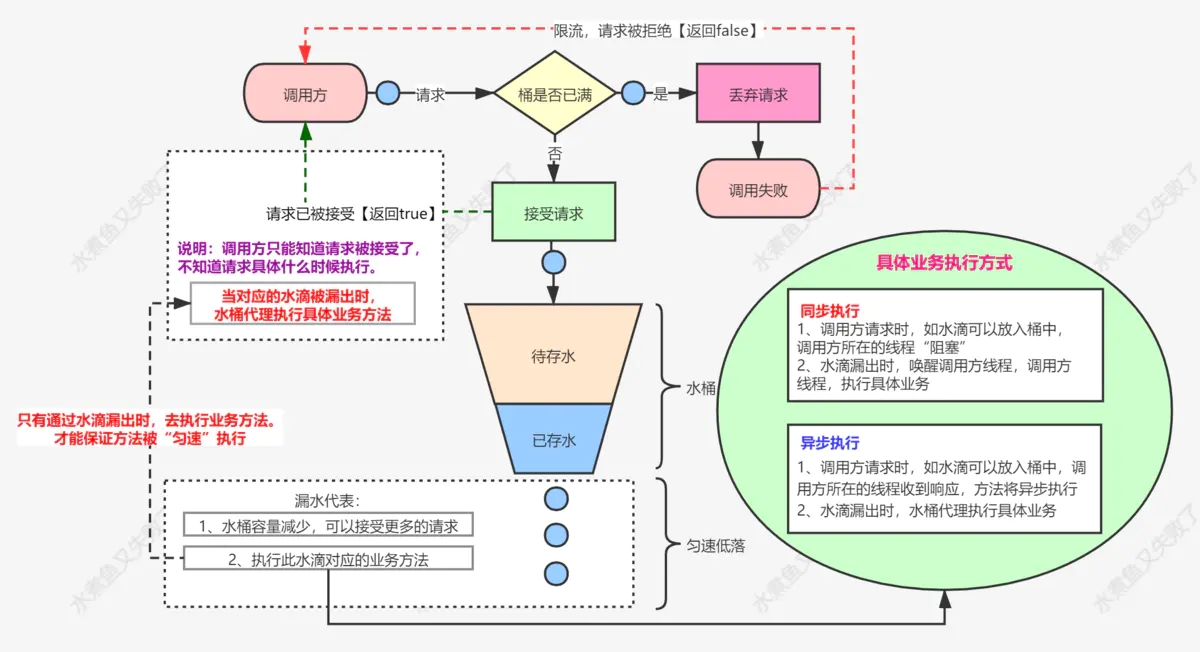
注意:水滴滴落的时候,才开始执行业务代码,而不是水滴进桶的时候,去执行业务代码。
业务代码的执行方式,个人认为有如下两种:
同步执行:
- 调用方请求时,如水滴可以放入桶中,调用方所在的线程“阻塞”
- 水滴漏出时,唤醒调用方线程,调用方线程,执行具体业务
异步执行:
- 调用方请求时,如水滴可以放入桶中,调用方所在的线程收到响应,方法将异步执行
- 水滴漏出时,水桶代理执行具体业务
网上很多滴桶的实现代码,在水滴进桶的时候,就去执行业务代码了。这样会导致业务代码,
无法匀速地执行,仍然对被调用的接口有一瞬间流量的冲击(和令牌桶算法的最终实现效果一样)。
2.2.3 适用场景
水桶的进水速度是不可控的,有可能一瞬间有大量的请求进入水桶。处理请求的速度是恒定的(滴水的时候处理请求)。
此算法,主要应用于自己的服务,调用外部接口。以均匀的速度调用外部接口,防止对外部接口的压力过大,而影响外部系统的稳定性。如果影响了别人的系统,接口所在公司会来找你喝茶。
漏桶算法,主要用来保护别人的接口。
2.2.4 代码
本实例代码的实现,在水滴滴下,执行具体业务代码时,采用同步执行的方式。即唤醒调用方的线程,让"调用者"所属的线程去执行具体业务代码,去调用接口。
|
1
2
3
4
5
6
7
8
9
10
11
12
13
14
15
16
17
18
19
20
21
22
23
24
25
26
27
28
29
30
31
32
33
34
35
36
37
38
39
40
41
42
43
44
45
46
47
48
49
50
51
52
53
54
55
56
57
58
59
60
61
62
63
64
65
66
67
68
69
70
71
72
73
74
75
76
77
78
79
80
81
82
83
84
85
86
87
88
89
90
91
92
93
94
95
96
97
98
99
100
101
102
103
104
105
|
import java.net.sockettimeoutexception;import java.time.localdatetime;import java.util.queue;import java.util.uuid;import java.util.concurrent.arrayblockingqueue;import java.util.concurrent.blockingqueue;import java.util.concurrent.linkedblockingqueue;import java.util.concurrent.timeunit;import java.util.concurrent.locks.locksupport;/** * 漏桶算法 */public class leakybucketlimiterutil { /** * 漏桶流出速率(多少纳秒执行一次) */ private long outflowratenanos; /** * 漏桶容器 */ private volatile blockingqueue<drip> queue; /** * 滴水线程 */ private thread outflowthread; /** * 水滴 */ private static class drip { /** * 业务主键 */ private string busid; /** * 水滴对应的调用者线程 */ private thread thread; public drip(string busid, thread thread) { this.thread = thread; } public string getbusid() { return this.busid; } public thread getthread() { return this.thread; } } /** * @param second 秒 * @param time 调用次数 */ public leakybucketlimiterutil(int second, int time) { if (second <= 0 || time <= 0) { throw new illegalargumentexception("second and time must by positive"); } outflowratenanos = timeunit.seconds.tonanos(second) / time; queue = new linkedblockingqueue<>(time); outflowthread = new thread(() -> { while (true) { drip drip = null; try { // 阻塞,直到从桶里拿到水滴 drip = queue.take(); } catch (exception e) { e.printstacktrace(); } if (drip != null && drip.getthread() != null) { // 唤醒阻塞的水滴里面的线程 locksupport.unpark(drip.getthread()); } // 休息一段时间,开始下一次滴水 locksupport.parknanos(this, outflowratenanos); } }, "漏水线程"); outflowthread.start(); } /** * 业务请求 * * @return */ public boolean acquire(string busid) { thread thread = thread.currentthread(); drip drip = new drip(busid, thread); if (this.queue.offer(drip)) { locksupport.park(); return true; } else { return false; } }} |
测试代码如下:
|
1
2
3
4
5
6
7
8
9
10
11
12
13
14
15
16
17
18
|
public static void main(string[] args) throws exception { // 1秒限制执行1次 leakybucketlimiterutil leakybucketlimiter = new leakybucketlimiterutil(5, 2); for (int i = 0; i < 10; i++) { new thread(new runnable() { @override public void run() { string busid = "[业务id:" + localdatetime.now().tostring() + "]"; if (leakybucketlimiter.acquire(busid)) { system.out.println(localdatetime.now() + " " + thread.currentthread().getname() + ":调用外部接口...成功:" + busid); } else { system.out.println(localdatetime.now() + " " + thread.currentthread().getname() + ":调用外部接口...失败:" + busid); } } }, "测试线程-" + i).start(); timeunit.milliseconds.sleep(500); }} |
执行结果如下:
|
1
2
3
4
5
6
7
8
9
10
|
2021-05-31t20:52:52.297 测试线程-0:调用外部接口...成功:[业务id:2021-05-31t20:52:52.295]2021-05-31t20:52:53.782 测试线程-3:调用外部接口...失败:[业务id:2021-05-31t20:52:53.782]2021-05-31t20:52:54.286 测试线程-4:调用外部接口...失败:[业务id:2021-05-31t20:52:54.286]2021-05-31t20:52:54.799 测试线程-1:调用外部接口...成功:[业务id:2021-05-31t20:52:52.761]2021-05-31t20:52:55.300 测试线程-6:调用外部接口...失败:[业务id:2021-05-31t20:52:55.300]2021-05-31t20:52:55.806 测试线程-7:调用外部接口...失败:[业务id:2021-05-31t20:52:55.806]2021-05-31t20:52:56.307 测试线程-8:调用外部接口...失败:[业务id:2021-05-31t20:52:56.307]2021-05-31t20:52:56.822 测试线程-9:调用外部接口...失败:[业务id:2021-05-31t20:52:56.822]2021-05-31t20:52:57.304 测试线程-2:调用外部接口...成功:[业务id:2021-05-31t20:52:53.271]2021-05-31t20:52:59.817 测试线程-5:调用外部接口...成功:[业务id:2021-05-31t20:52:54.799] |
2.3 令牌桶算法
2.3.1 说明
令牌桶算法,主要是匀速地增加可用令牌,令牌数因为桶的限制有数量上限。
请求拿到令牌,相当于拿到授权,即可进行相应的业务操作。
2.3.2 令牌桶算法图示
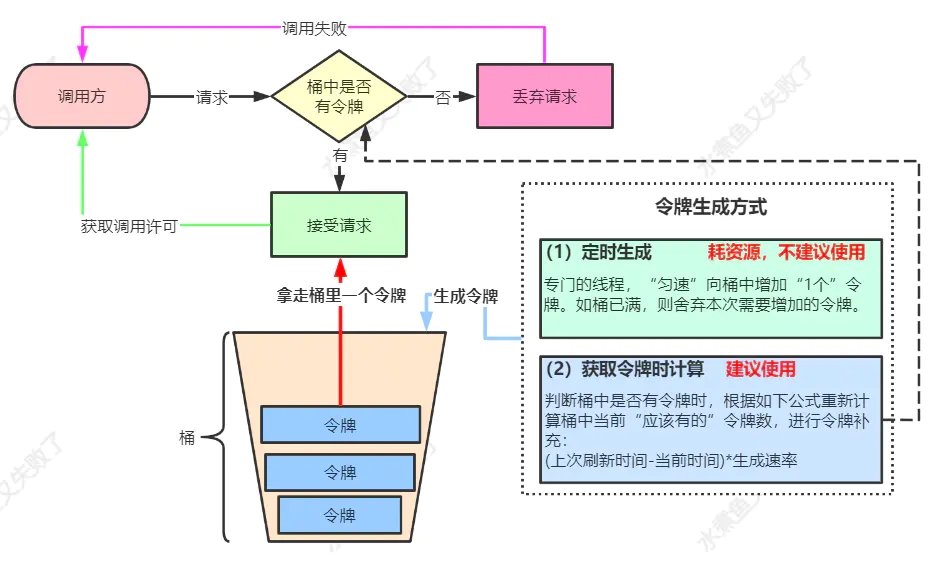
2.3.3 适用场景
和漏桶算法比,有可能导致短时间内的请求数上升(因为拿到令牌后,就可以访问接口,有可能一瞬间将所有令牌拿走),但是不会有计数算法那样高的峰值(因为令牌数量是匀速增加的)。
一般自己调用自己的接口,接口会有一定的伸缩性,令牌桶算法,主要用来保护自己的服务器接口。
2.3.4 代码
代码实现如下:
|
1
2
3
4
5
6
7
8
9
10
11
12
13
14
15
16
17
18
19
20
21
22
23
24
25
26
27
28
29
30
31
32
33
34
35
36
37
38
39
40
41
42
43
44
45
46
47
48
49
50
51
52
53
54
55
56
57
58
59
60
61
62
63
64
65
66
67
68
69
70
71
72
73
74
|
import java.time.localdatetime;import java.util.concurrent.timeunit;/** * 令牌桶限流算法 */public class tokenbucketlimiter { /** * 桶的大小 */ private double bucketsize; /** * 桶里的令牌数 */ private double tokencount; /** * 令牌增加速度(每毫秒) */ private double tokenaddratemillsecond; /** * 上次更新时间(毫秒) */ private long lastupdatetime; /** * @param second 秒 * @param time 调用次数 */ public tokenbucketlimiter(double second, double time) { if (second <= 0 || time <= 0) { throw new illegalargumentexception("second and time must by positive"); } // 桶的大小 this.bucketsize = time; // 桶里的令牌数 this.tokencount = this.bucketsize; // 令牌增加速度(每毫秒) this.tokenaddratemillsecond = time / second / 1000; // 上次更新时间(毫秒) this.lastupdatetime = system.currenttimemillis(); } /** * 刷新桶内令牌数(令牌数不得超过桶的大小) * 计算“上次刷新时间”到“当前刷新时间”中间,增加的令牌数 */ private void refreshtokencount() { long now = system.currenttimemillis(); this.tokencount = math.min(this.bucketsize, this.tokencount + ((now - this.lastupdatetime) * this.tokenaddratemillsecond)); this.lastupdatetime = now; } /** * 尝试拿到权限 * * @return */ public synchronized boolean tryacquire() { // 刷新桶内令牌数 this.refreshtokencount(); if ((this.tokencount - 1) >= 0) { // 如果桶中有令牌,令牌数-1 this.tokencount--; return true; } else { // 桶中已无令牌 return false; } }} |
测试代码:
|
1
2
3
4
5
6
7
8
|
public static void main(string[] args) throws exception{ // 2秒执行1次 tokenbucketlimiter leakybucketlimiter = new tokenbucketlimiter(2, 1); for (int i = 0; i < 10; i++) { system.out.println(localdatetime.now() + " " + leakybucketlimiter.tryacquire()); timeunit.seconds.sleep(1); }} |
执行结果如下:
|
1
2
3
4
5
6
7
8
9
10
|
2021-05-31t21:38:34.560 true2021-05-31t21:38:35.582 false2021-05-31t21:38:36.588 true2021-05-31t21:38:37.596 false2021-05-31t21:38:38.608 true2021-05-31t21:38:39.610 false2021-05-31t21:38:40.615 true2021-05-31t21:38:41.627 false2021-05-31t21:38:42.641 true2021-05-31t21:38:43.649 false |
2.3.5 第三方工具类
可以使用guava中的ratelimiter来实现令牌桶的限流功能。
maven依赖如下:
|
1
2
3
4
5
|
<dependency> <groupid>com.google.guava</groupid> <artifactid>guava</artifactid> <version>30.1.1-jre</version></dependency> |
直接获取令牌(true为获取到令牌,false为获取失败):
|
1
2
3
4
5
6
7
|
ratelimiter ratelimiter = ratelimiter.create(2);boolean acquireresule = ratelimiter.tryacquire();if (acquireresule) { system.out.println("获取令牌:成功");} else { system.out.println("获取令牌:失败");} |
等待尝试获取令牌(阻塞当前线程,直到获取到令牌):
|
1
2
3
4
|
ratelimiter ratelimiter = ratelimiter.create(2);// 阻塞获取令牌double waitcount = ratelimiter.acquire();system.out.println("阻塞等待时间:" + waitcount); |
以上就是java限流算法详细的详细内容,更多关于java限流算法的资料请关注服务器之家其它相关文章!希望大家以后多多支持服务器之家!
原文链接:https://www.jianshu.com/p/d1c456399677



